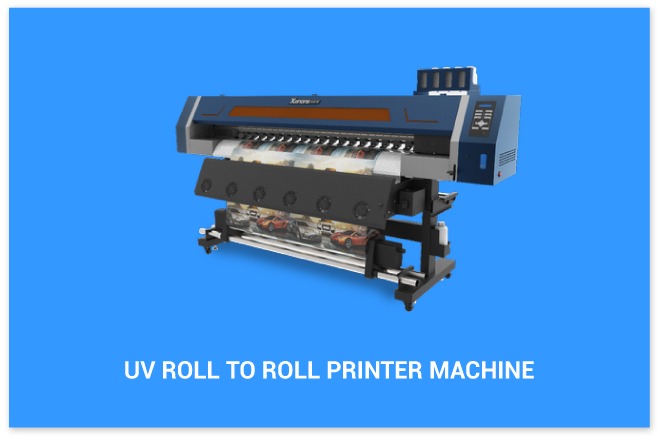UV roll-to-roll printing represents a groundbreaking advancement in the realm of graphic production. Unlike conventional printing methods, UV roll-to-roll printing harnesses ultraviolet (UV) light to instantly cure ink as it is applied to the substrate, leading to faster production speeds and enhanced print quality. This innovative technology has garnered significant attention for its ability to revolutionize the way we create graphics.
In UV roll-to-roll printing, the substrate, typically a flexible material such as vinyl or fabric, is fed continuously through the printer. As the substrate moves along the printing path, UV ink is deposited onto its surface. Immediately following the ink application, UV light is used to cure or dry the ink instantly, resulting in vibrant colors, sharp details, and a durable finish.
The efficiency and precision offered by UV roll-to-roll printing make it a preferred choice for various applications, ranging from signage and displays to packaging and promotional materials. Businesses across industries are increasingly adopting UV printing technology to elevate their graphic production capabilities and deliver outstanding results to their clients.
We will delve deeper into the advantages of UV roll-to-roll printing, exploring its impact on efficiency, quality, and versatility in graphic production. Additionally, we will examine the diverse applications of UV printing and provide insights into how businesses can leverage this technology to achieve their printing goals effectively.

How UV Roll-To-Roll Printing Improves Efficiency
Instant Ink Curing:
Unlike traditional printing methods that rely on air drying or heat curing, UV roll-to-roll printing utilizes UV light to instantly cure the ink as it is applied to the substrate. This rapid curing process eliminates the need for drying time between print layers, allowing for continuous printing and minimizing production delays.
Faster Production Speeds:
With the elimination of drying time, UV roll-to-roll printing achieves faster production speeds compared to conventional printing methods. This accelerated printing process enables businesses to fulfill orders more quickly, meeting tight deadlines and increasing overall productivity.
Reduced Waste:
UV roll-to-roll printing produces less waste compared to traditional printing methods. Since UV ink dries instantly upon exposure to UV light, there is minimal ink spread or absorption into the substrate, resulting in cleaner, more precise prints. This reduction in waste translates to cost savings for businesses and contributes to a more sustainable production process.
Versatile Substrate Compatibility:
UV roll-to-roll printing is compatible with a wide range of substrates, including flexible materials such as vinyl, fabric, and paper, as well as rigid materials like plastics, metals, and glass. This versatility allows businesses to consolidate their printing processes and streamline production workflows, reducing the need for multiple printing technologies and equipment setups.
Enhanced Color Reproduction:
UV roll-to-roll printing offers superior color reproduction and image clarity compared to traditional printing methods. The UV ink’s ability to cure instantly upon contact with the substrate results in vibrant colors, crisp details, and consistent print quality across various materials and applications. This enhanced color fidelity enhances the visual impact of printed graphics, making them more appealing to customers and stakeholders.
By improving efficiency through instant ink curing, faster production speeds, reduced waste, versatile substrate compatibility, and enhanced color reproduction, UV roll-to-roll printing enables businesses to optimize their graphic production processes and achieve greater success in today’s competitive market landscape.
Advantages of UV Printing in Graphic Production
UV printing offers numerous advantages in graphic production, making it a preferred choice for businesses across various industries. Here are some key benefits of UV printing:
Enhanced Print Quality: UV printing delivers exceptional print quality with sharp details, vibrant colors, and high-resolution imagery. The UV ink cures instantly upon contact with the substrate, resulting in crisp, precise prints that stand out and captivate viewers.
Versatility in Substrate Compatibility:
UV printing is compatible with a wide range of substrates, including paper, cardboard, plastics, metals, glass, and more. This versatility allows businesses to print on diverse materials, opening up new creative possibilities for product packaging, signage, displays, and promotional materials.
Fast Production Speeds:
UV printing offers rapid production speeds due to its instant drying capabilities. Unlike traditional printing methods that require time-consuming drying processes, UV printing allows for continuous printing without waiting for ink to dry. This leads to faster turnaround times and increased productivity.
Environmentally Friendly:
UV printing is an environmentally friendly option compared to solvent-based printing methods. UV inks do not contain volatile organic compounds (VOCs), reducing emissions and minimizing environmental impact. Additionally, UV printing produces less waste and requires fewer cleaning solvents, contributing to a more sustainable printing process.
Durability and Longevity:
UV prints are highly durable and resistant to fading, scratches, and moisture damage. The UV ink forms a protective layer on the substrate, ensuring long-lasting print quality even in challenging environments. This durability makes UV printing ideal for outdoor signage, vehicle wraps, and other applications requiring robust graphics.
Special Effects and Finishing Options:
UV printing offers a wide range of special effects and finishing options to enhance the visual appeal of printed materials. These include raised textures, glossy or matte finishes, spot varnishes, and embossing, allowing businesses to create unique and eye-catching designs that leave a lasting impression on customers.
